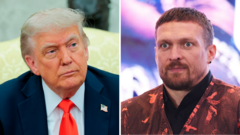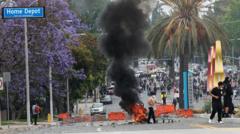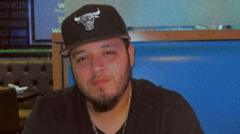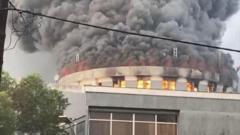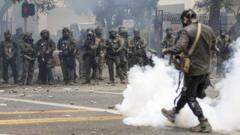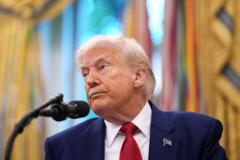In Los Angeles, President Trump's rapid intervention during protests showcases his commitment to law and order, yet sparks debate among critics regarding its necessity and implications.
Trump's Bold Moves in LA: A Controversial Response to Protests
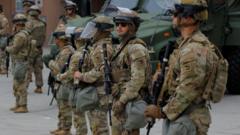
Trump's Bold Moves in LA: A Controversial Response to Protests
Amid clashes over immigration enforcement, Trump's swift actions may rally his supporters but ignite further tensions.
Despite assurances from the Los Angeles Police Department that protests against Immigration and Customs Enforcement (ICE) were mostly non-violent, President Donald Trump saw an opportunity to assert his authority. Addressing the tension, he cited claims from his administration that local law enforcement had inadequately supported immigration agents amidst escalating unrest.
During an interview, Homeland Security Secretary Kirsty Noem emphasized the necessity of a swift response, indicating that LAPD's delayed actions were unacceptable given the chaotic situation. This led Trump to federalize 2,000 California National Guard troops, despite opposition from Governor Gavin Newsom. Notably, Defense Secretary Pete Hegseth hinted at U.S. Marines being on "high alert," a move that signifies the potential deployment of active military forces for domestic disturbances.
As protests unfolded, calling for immigration reform and equity, Trump projected confidence, thanking the National Guard for bringing about peace even before their full deployment. This reflects a strategic approach from the Trump administration, framing strict immigration enforcement and law enforcement as pivotal electoral issues that resonate with his support base and independent voters worried about safety.
Noem referenced previous protests in 2020, asserting that this administration would not permit similar situations to escalate unchecked again. However, Democrats expressed disapproval over the president's tactics. Senator Cory Booker argued that the administration's aggressive stance would exacerbate tensions, asserting that such actions undermine peaceful protests and generate further unrest.
As summer approaches, concerns mount about the potential for increased civil disturbances. While these California demonstrations may represent isolated incidents, they might also signal a more significant wave of dissent, challenging Trump's handling of public safety and immigration issues.
During an interview, Homeland Security Secretary Kirsty Noem emphasized the necessity of a swift response, indicating that LAPD's delayed actions were unacceptable given the chaotic situation. This led Trump to federalize 2,000 California National Guard troops, despite opposition from Governor Gavin Newsom. Notably, Defense Secretary Pete Hegseth hinted at U.S. Marines being on "high alert," a move that signifies the potential deployment of active military forces for domestic disturbances.
As protests unfolded, calling for immigration reform and equity, Trump projected confidence, thanking the National Guard for bringing about peace even before their full deployment. This reflects a strategic approach from the Trump administration, framing strict immigration enforcement and law enforcement as pivotal electoral issues that resonate with his support base and independent voters worried about safety.
Noem referenced previous protests in 2020, asserting that this administration would not permit similar situations to escalate unchecked again. However, Democrats expressed disapproval over the president's tactics. Senator Cory Booker argued that the administration's aggressive stance would exacerbate tensions, asserting that such actions undermine peaceful protests and generate further unrest.
As summer approaches, concerns mount about the potential for increased civil disturbances. While these California demonstrations may represent isolated incidents, they might also signal a more significant wave of dissent, challenging Trump's handling of public safety and immigration issues.


